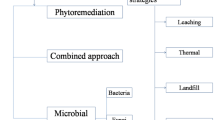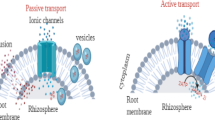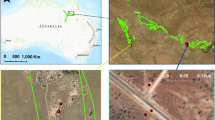Abstract
This study investigated the growth response of Ranunculus sceleratus to pollution and its capacity to accumulate trace metals for its use as a phytoremediator in Lake Maruit, Egypt. Three basins (main basin, fish farm, and southwestern basin) representing the natural distribution of the plant as well as the pollution loads in the lake, were chosen for collecting plant and sediment samples. In each basin ten quadrats (0.5 m × 0.5 m), distributed equally along two sites, were selected for measuring growth parameters, nutrients, and trace metal concentration. The highest biomass of the shoot and root (610 and 236 g m−2) was recorded in the main basin and fish farm, respectively. R. sceleratus accumulated high concentrations of Cu and Pb (27.7 and 9.9 mg kg−1), while toxic concentration of Mn (2508.0 mg kg−1) in their roots compared to shoots. The bioaccumulation factor (BF) for the investigated metals was greater than one, and in the decreasing order: Ni (27.1) > Zn (20.0) > Cd (16.4) > Cu (7.7) > Mn (3.9) > Pb (3.6). The translocation factor of all analyzed trace metals was less than one. The ability of R. sceleratus to accumulate Mn, Ni, Cu, and Pb in its roots indicates the potential use of this species for phytostabilization of these metals (mainly Mn) in contaminated water bodies.



Similar content being viewed by others
References
Allen SE (1989) Chemical analysis of ecological materials. Blackwell Scientific Publications, London
APHA, AWWA and WEF (American Public Health Association, American Water Works Association and Water Environment Federation) (2005) Standard methods for the examination of water and wastewater, 21st edn. American Public Health Association, Washington, DC
Baker AJM (1981) Accumulators and excluders-strategies in the response of plants to heavy metals. J Plant Nutr 3(1-4):643–654. https://doi.org/10.1080/01904168109362867
Bonanno G (2013) Trace element accumulation and distribution in the organs of Phragmites australis (common reed) and biomonitoring applications. Ecotox Environ Safe 74:1057–1064
Bonanno G, Lo Giudice R (2010) Heavy metal bioaccumulation by the organs of Phragmites australis (common reed) and their potential use as contamination indicators. Ecol Indic 10:39–645
Bonanno G, Borg JA, DiMartino V (2017) Levels of heavy metals in wetland and marine vascular plants and their biomonitoring potential: a comparative assessment. Sci Total Environ 576:796–806. https://doi.org/10.1016/j.scitotenv.2016.10.171
Boulos L (1999) Flora of Egypt, volume 1 (AzoIlaceae – Oxalidaceae). Al Hadara Publishing, Egypt
Chakravarty P, SenSarma N, Sarma HP (2010) Biosorption of cadmium (II) from aqueous solution using heartwood powder of Areca catechu. Chem Eng J 162(3):949–955. https://doi.org/10.1016/j.cej.2010.06.048
Chandra R, Yadav S, Yadav S (2017) Phytoextraction potential of heavy metals by native wetland plants growing on chlorolignin containing sludge of pulp and paper industry. Ecol Eng 98:134–145. https://doi.org/10.1016/j.ecoleng.2016.10.017
Christou A, Theologides CP, Costa C, Kalavrouziotis IK, Varnavas SP (2017) Assessment of toxic heavy metals concentrations in soils and wild and cultivated plant species in Limni abandoned copper mining site, Cyprus. J Geochem Explor 178:16–22. https://doi.org/10.1016/j.gexplo.2017.03.012
Cronk JK, Fennessy MS (2001) Wetlands plants: biology and ecology. Lewis Publisher, Boca Raton, Florida. https://doi.org/10.1201/9781420032925
Dhir B (2013) Phytoremediation: role of aquatic plants in environmental clean-up. Springer, India. https://doi.org/10.1007/978-81-322-1307-9
Dummee V, Kruatrachue M, Trinachartvanit W, Tanhan P, Pokethitiyook P, Damrongphol P (2012) Bioaccumulation of heavy metals in water, sediments, aquatic plant and histopathological effects on the golden apple snail in Beung Boraphet reservoir, Thailand. Ecotox Environ Safe 86:204–212. https://doi.org/10.1016/j.ecoenv.2012.09.018
Eid EM, Shaltout KH (2014) Monthly variations of trace elements accumulation and distribution in above- and below-ground biomass of Phragmites australis (Cav.) Trin. Ex Steudel in Lake Burullus (Egypt): a biomonitoring application. Ecol Eng 73:17–25. https://doi.org/10.1016/j.ecoleng.2014.09.006
Eid EM, Shaltout KH, El-Sheikh MA, Asaeda T (2012) Seasonal courses of nutrients and heavy metals in water, sediment and above- and below-ground Typha domingensis biomass in Lake Burullus (Egypt): perspective for phytoremediation. Flora 207(11):783–794. https://doi.org/10.1016/j.flora.2012.09.003
Farahat E, Linderholm HW (2015) The effect of long-term wastewater irrigation on accumulation and transfer of heavy metals in Cupressus sempervirens leaves and adjacent soils. Sci Total Environ 512-513:1–7. https://doi.org/10.1016/j.scitotenv.2015.01.032
Galal TM (2005) Flora and Vegetation of the Northern Lakes of Egypt. Dissertation, Helwan University, Ph.D
Galal TM, Farahat E (2015) The invasive macrophyte Pistia stratiotes L. as a bioindicator and a biomonitor for water pollution in Lake Mariut, Egypt. Environ Monit Assess 187(11):701–711. https://doi.org/10.1007/s10661-015-4941-4
Galal TM, Shehata HS (2014) Evaluation of the invasive macrophyte Myriophyllum spicatum L. as a bioaccumulator for heavy metals in some water courses of Egypt. Ecol Indic 41:209–214. https://doi.org/10.1016/j.ecolind.2014.02.004
Galal TM, Shehata HS (2015) Bioaccumulation and translocation of heavy metals by Plantago major L. grown in contaminated soils under the effect of traffic pollution. Ecol Indic 48:244–251. https://doi.org/10.1016/j.ecolind.2014.08.013
Galal TM, Shehata HS (2016) Growth and nutrients accumulation potentials of giant reed (Arundo donax L.) in different habitats in Egypt. Int J Phytorem 18(12):1221–1230
Galal TM, Farahat E, Fawzy M (2008) Submerged macrophytes as bioindicators for pollution in Lake Mariut along the Mediterranean coast of Egypt. Ecol Medit 34:83–91
Ghaderian SM, Ravandi AAG (2012) Accumulation of copper and other heavy metals by plants growing on Sarcheshmeh copper mining area, Iran. J Geochem Expl 123:25–32. https://doi.org/10.1016/j.gexplo.2012.06.022
Guo AH, Niu FS, Jia JM (2010) Research on landscape water body eutrophication treatment with some species of wetland plants. N Environ 22:37–39
Guo BJ (1985) A technique for monitoring pollutants by means of micronuclear cells in root-tip cells of Ranunculus sceleratus. Acta Sci Circum 5:322–326
Gupta S, Nayek S, Saha RN, Satpati S (2008) Assessment of heavy metal accumulation in macrophyte, agricultural soil and crop plants adjacent to discharge zone of sponge iron factory. Environ Geol 55(4):731–739. https://doi.org/10.1007/s00254-007-1025-y
Hadi F, Bano A, Fuller MP (2010) The improved phytoextraction of lead (Pb) and the growth of maize (Zea mays L.): the role of plant growth regulators (GA3 and IAA) and EDTA alone and in combinations. Chemosphere 80(4):457–462. https://doi.org/10.1016/j.chemosphere.2010.04.020
Hadi F, Hussain F, Hussain M, Sanaullah Ahmad A, Ur Rahman S, Ali N (2014) Phytoextraction of Pb and Cd; the effect of Urea and EDTA on Cannabis sativa growth under metals stress. Int J Agron Agricult Res 5(3):30–39
Hu JF, Wang XM, Shi GR, Hu ZD (2007) The purification of Fe2+ in wastewater with Ranunculus sceleratus in gardens. J Huaibei Coal Indust Teach College 28:31–33
Kabata-Pendias A (2011) Trace elements in soils and plants. CRC Press, Florida, Boca Raton
Konar RN, Thomas E, Strfet HE (1972) Origin and structure of embryoids arising from epidermal cells of the stem of Ranunculus Sceleratus L. J Cell Sci 5:77–93
Kumar PBAN, Dushenkov V, Motto H, Rasakin I (2006) Phytoextraction: the use of plants to remove heavy metals from soils. Environ Sci Technol 29:1232–1238
Lente I, Ofosu-Anim J, Brimah A, Atiemo S (2014) Heavy metal pollution of vegetable crops irrigated with wastewater in Accra, Ghana. West Afri. J Appl Ecol 22:41–58
Luan XL, Wang X, Shi YZ, Qiang YY, Zhao Y (2008) Study on ability of absorbing nitrogen and phosphorus from domestic sewage with wetland plants. Jiangsu J Agric Sci 4:296–298
Lytle JS, Lytle TF (2001) Use of plants for toxicity assessment of estuarine ecosystems. Environ Toxic Chem 20(1):68–83. https://doi.org/10.1002/etc.5620200107
Maltby E (1992) Soil and wetland functions. In: Gerakis PA (ed) Conservation and Management of Greek Wetlands. The IUCN wetlands Programme, pp 9–60
Meeinkuirt W, Pokethitiyook P, Kruatrachue M, Tanhan P, Chaiyarat R (2012) Phytostabilzation of a Pb-contaminated tailing by various tree species in pot and field trail experiments. Int J Phytoremediat 14(9):925–938. https://doi.org/10.1080/15226514.2011.636403
Mei H, Zuo S, Ye L, Wang J, Ma S (2012) Review of the application of the traditional Chinese medicinal herb, Ranunculus sceleratus Linn. J Med Plants Res 6(10):1821–1826
Nanda S, Abraham J (2013) Remediation of heavy metal contaminated soil. Afri J Biotechnol 12(21):3099–3109
Oyuela Leguizamo MA, Gómez WDF, Sarmiento MCG (2017) Native herbaceous plant species with potential use in phytoremediation of heavy metals, spotlight on wetlands: a review. Chemosphere 168:1230–1247. https://doi.org/10.1016/j.chemosphere.2016.10.075
Peng K, Luo C, Lou L, Li X, Shen Z (2008) Bioaccumulation of heavy metals by the aquatic plants Potamogeton pectinatus L. and Potamogeton malaianus Miq. and their potential use for contamination indicators and in wastewater treatment. Sci Total Environ 392(1):22–29. https://doi.org/10.1016/j.scitotenv.2007.11.032
Phusantisampan T, Meeinkuirt W, Saengwilai P, Pichtel J, Chaiyarat R (2016) Phytostabilization potential of two ecotypes of Vetiveria zizanioides in cadmium-contaminated soils: greenhouse and field experiments. Environ Sci Pollut R 23(19):20027–20038. https://doi.org/10.1007/s11356-016-7229-5
Roussiez V, Ludwig W, Monaco A, Probst JL, Bouloubassi I, Buscail R, Saragoni G (2006) Sources and sinks of sediment-bound contaminants in the Gulf of Lions (NW Mediterranean Sea): a multi-tracer approach. Cont Shelf Res 26:843–1857
Sawidis T, Breuste J, Mitrovic M, Pavlovic P, Tsigaridas K (2011) Trees as bioindicator of heavy metal pollution in three European cities. Environ Pollut 159(12):3560–3570. https://doi.org/10.1016/j.envpol.2011.08.008
SPSS (2012) IBM-SPSS software, version 21.0. Chicago: SPSS Inc.
Susarla S, Medina VF, McCutcheon SC (2002) Phytoremediation, an ecological solution to organic contamination. Ecol Eng 18(5):647–658. https://doi.org/10.1016/S0925-8574(02)00026-5
Taskila S, Tuomola M, Ojamo H (2012) Enrichment cultivation in detection of food-borne salmonella. Food Cont 26(2):369–377. https://doi.org/10.1016/j.foodcont.2012.01.043
Xiao R, Bai J, Zhang H, Gao H, Liua X, Wilkes A (2011) Changes of P, Ca, Al and Fe contents in fringe marshes along a pedogenic chronosequence in the Pearl River estuary, South China. Cont Shelf Res 31(6):739–747. https://doi.org/10.1016/j.csr.2011.01.013
Yan C, Li G, Xue P, Wei Q, Li Q (2010) Competitive effect of Cu (II) and Zn on the biosorption of lead (II) by Myriophyllum spicatum. J Hazard Mater 179(1-3):721–728. https://doi.org/10.1016/j.jhazmat.2010.03.061
Acknowledgements
The authors are grateful to the editor and the two anonymous reviewers for their helpful comments and suggestions that significantly improved the manuscript. We thank Prof. Gamal Fahmy (Cairo University) for his revision to the manuscript.
Author information
Authors and Affiliations
Corresponding author
Additional information
Responsible editor: Elena Maestri
Rights and permissions
About this article
Cite this article
Farahat, E.A., Galal, T.M. Trace metal accumulation by Ranunculus sceleratus: implications for phytostabilization. Environ Sci Pollut Res 25, 4214–4222 (2018). https://doi.org/10.1007/s11356-017-0808-2
Received:
Accepted:
Published:
Issue Date:
DOI: https://doi.org/10.1007/s11356-017-0808-2




